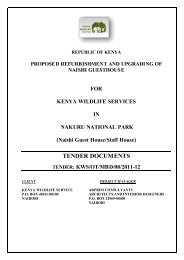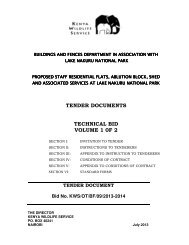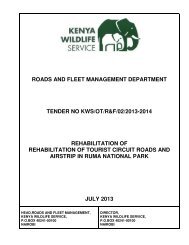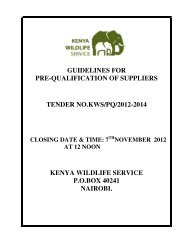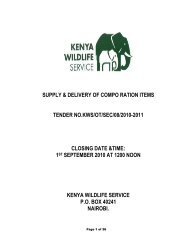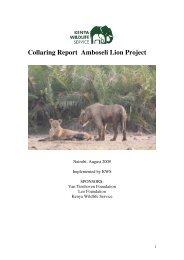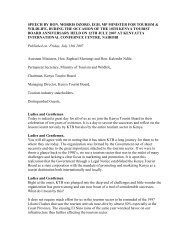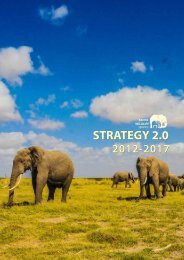Conservation and Management Strategy for the Elephant in Kenya
Conservation and Management Strategy for the Elephant in Kenya
Conservation and Management Strategy for the Elephant in Kenya
You also want an ePaper? Increase the reach of your titles
YUMPU automatically turns print PDFs into web optimized ePapers that Google loves.
CONSERVATION AND MANAGEMENT STRATEGY FOR THE ELEPHANT IN KENYA 35<br />
[ BELOW ] Plate 30.<br />
3.2 Overall Goal<br />
Two young males test<strong>in</strong>g each o<strong>the</strong>r’s strength by play-sparr<strong>in</strong>g<br />
Cynthia Moss, Amboseli Trust <strong>for</strong> <strong>Elephant</strong>s<br />
Ma<strong>in</strong>ta<strong>in</strong> <strong>and</strong> exp<strong>and</strong> elephant<br />
distribution <strong>and</strong> numbers <strong>in</strong><br />
suitable areas, enhance<br />
security to elephants, reduce<br />
human-elephant conflict <strong>and</strong><br />
<strong>in</strong>crease value of elephants<br />
to people <strong>and</strong> habitat.<br />
3.2.1 Rationale <strong>and</strong> considerations<br />
<strong>Elephant</strong>s, more than any o<strong>the</strong>r large mammal, require a significant amount of space, or more critically, key areas of<br />
important habitat l<strong>in</strong>ked by movement corridors. Their <strong>for</strong>ag<strong>in</strong>g, social behaviour <strong>and</strong> life history are based on<br />
mobility, <strong>the</strong>ir ability to detect, remember <strong>and</strong> return to areas of favoured habitat or avoid areas of high risk.<br />
Restrict<strong>in</strong>g elephants’ movements creates all <strong>the</strong> ‘problems’ associated with elephants <strong>in</strong> <strong>the</strong> public m<strong>in</strong>d: conflict<br />
where <strong>the</strong>re is overlap between elephant <strong>and</strong> human populations, <strong>and</strong> perceived ‘overabundance’ lead<strong>in</strong>g to, or<br />
def<strong>in</strong>ed by, habitat change <strong>in</strong> <strong>the</strong> restricted core areas.<br />
Solutions based on control of elephant numbers by lethal management – control shoot<strong>in</strong>g or cull<strong>in</strong>g – are<br />
<strong>in</strong>effective, serv<strong>in</strong>g only to exacerbate conflict problems, as surviv<strong>in</strong>g elephants’ memories of events promotes future<br />
aggressive behaviour, <strong>and</strong> concentration problems, as elephant retreat from confrontation zones to converge on<br />
core PAs.<br />
The 1991–1996 KWS Policy Framework <strong>and</strong> Development Programme emphasised protection of elephant<br />
populations after a period of severe poach<strong>in</strong>g, reduc<strong>in</strong>g HEC <strong>and</strong> secur<strong>in</strong>g habitat through agreements with<br />
communities. These ef<strong>for</strong>ts have been largely successful <strong>in</strong> protect<strong>in</strong>g elephants <strong>and</strong> <strong>in</strong> build<strong>in</strong>g <strong>the</strong> basis <strong>for</strong><br />
work<strong>in</strong>g with communities. In broad terms, <strong>the</strong> elephant population is secure overall, reasonably large <strong>and</strong>, <strong>in</strong> many<br />
parts of <strong>the</strong> country, grow<strong>in</strong>g steadily. However, <strong>the</strong> same objectives rema<strong>in</strong> important today. Security <strong>in</strong> <strong>for</strong>mer<br />
range areas <strong>in</strong> nor<strong>the</strong>rn <strong>Kenya</strong> rema<strong>in</strong>s poor. In addition, <strong>the</strong> conversion of habitats through human use has<br />
cont<strong>in</strong>ued with <strong>in</strong>creas<strong>in</strong>g isolation <strong>and</strong> HEC. Fur<strong>the</strong>rmore, it has become clear that <strong>the</strong>re should be greater<br />
emphasis on partnerships, agreements <strong>and</strong> participatory l<strong>and</strong> use plann<strong>in</strong>g with communities <strong>and</strong> l<strong>and</strong> owners at<br />
<strong>the</strong> local level. Devolution of tenure <strong>and</strong> use rights to <strong>the</strong> lowest levels should be pursued, with attendant agreement<br />
of responsibilities <strong>for</strong> habitat ma<strong>in</strong>tenance. At higher governmental <strong>and</strong> political levels, <strong>the</strong>re should be new <strong>and</strong><br />
susta<strong>in</strong>ed ef<strong>for</strong>ts at harmonisation of legislation, policies <strong>and</strong> practices between different sectors towards a<br />
recognised role <strong>for</strong> natural resource conservation <strong>in</strong> general <strong>and</strong> elephant conservation <strong>in</strong> particular.



